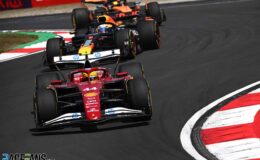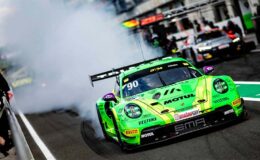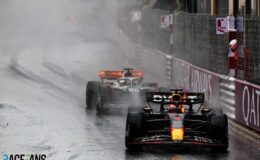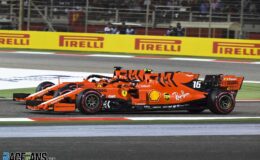Formula 1’s teams began work on sussing how the series’ new Monaco-specific tyre rules might affect the race long before the weekend began.
But once the preliminary grid for the race was set yesterday, the competitors gained a much clearer idea of how the need to make two tyre changes instead of the usual one might affect them. As George Russell admitted, Mercedes made their original calculations based on the assumption they would qualify near the front, rather than 14th and 15th.
As teams unravel the many possibilities the race may hold, one point becomes clear: opportunities exist for those prepared to push the rules to and beyond the limit.
F1 introduced its new rule in reaction to last year’s dismal race, where the entire field completed its mandatory tyre change when the race was red-flagged on the first lap. Looking back at the tyre selections teams made for the start of that race, it’s clear each team had one of two strategies in mind: Start on the medium rubber, wait for a suitable gap in traffic to appear behind and then pit, or start on the hard tyre and be prepared to run slightly longer and do the same.
Although the requirement to pit twice is new, teams will still be driven by familiar priorities in Monaco, which are no different to those elsewhere. These are: run in clear air when possible and grab the opportunity to make a low-cost tyre change if one appears, through either type of Safety Car or a red flag.
As last year’s race demonstrated, teams can easily cover the race distance in Monaco without pitting at all. They wouldn’t pit once, let alone twice, if the rules didn’t force them to. Therefore they can take their pit stops more or less when they choose to best serve the tactical opportunities available to them on the track.
Previously, when they only needed to change tyres once, teams delayed doing so as long as possible in the hope of being able to make a low-cost pit stop. Around narrow Monaco, the risk of a Safety Car period or similar is high to begin with, but the chances of two such interruptions during a race are inevitably lower than one. Therefore teams may be keener to risk an earlier pit stop under green flag conditions.
Advert | Become a RaceFans supporter and
The candidates for that strategy are easy to identify: Pretty much any driver who is outside the points positions by the end of lap one. Many expect the pit lane to become busy immediately.
If that happens, which cars in the front half of the field will react in order to avoid being ‘undercut’, and who will be content to risk running at the front of the field for an extended period without having made a pit stop? That risk could be rewarded later by an interruption to the race.
Any of the three kinds of interruption could affect the race differently. A red flag would effectively turn the race into the usual one-stopper.

This kind of race suspension would be a godsend for any driver running at or near the front who has only changed tyres once, allowing them to run to the end without a further pit stop. It would be helpful for any driver still on their original rubber, allowing them to get one tyre change in and potentially securing them a position ahead of any driver who’s pitted once. And it would likely be a disaster for any driver who has already completed their two mandatory tyre changes, unless they are leading.
A Safety Car period would offer every driver the chance to pit. Given the two mandatory pit stops it would likely change the race in much the same way as a red flag.
A Virtual Safety Car period could mix things up most of all, however, as these often do not apply for long enough for every driver to make a pit stop. There is a significant luck factor here, though this is not unique to Monaco.
Advert | Become a RaceFans supporter and
Every driver on the grid will be craving an opportunity to get a few laps of running in clear air to make the difference in what can often be a frustrating race. The front running teams have largely kept their options open by ensuring they have sets of untouched medium and hard compound tyres available. Max Verstappen ran a notably strong stint on the medium rubber in final practice, but for Red Bull like all teams, manoeuvring him into a position to use it will be difficult.
Some teams may therefore resort to sacrificing one driver to assist the other. This has happened before, as Alexander Albon noted before the weekend began, citing the example of Haas at Jeddah last year.
It isn’t likely to be an option for all teams, such as McLaren, given their drivers’ positions in the championship. Verstappen can rely on Yuki Tsunoda’s help, however. Other teams go into the race knowing one driver is in a much stronger position than the other, such as Aston Martin (Fernando Alonso sixth, Lance Stroll 19th) and Haas (Esteban Ocon eighth, Oliver Bearman 20th).
There are a few ways teams could use one driver strategically to help another. In the example of Haas last year, the team used Kevin Magnussen to slow down cars behind him so Nico Hulkenberg could build up a lead over them, make his pit stop and come out ahead. Teams can also use their second-running driver as a ‘filter’, pitting the lead driver behind them, letting them through, then holding up the rest.
A more contentious possibility is we could see similar interactions between drivers from rival teams. Suspicion will inevitably fall on Red Bull and Racing Bulls, as the two share the same owner. However some drivers have been given a suspiciously easy time by supposed rivals in Monaco in the past as well – recall how generous Ocon was to Lewis Hamilton in the 2018 race, when the two were connected via Mercedes.
For a driver to aid their team by holding up a rival, they need to be able to lap well off the leaders’ pace without being passed. But the driver behind could take it into their own hands to stop that happening. If they think they are in danger of losing a significant amount of time behind a rival, they may choose to cut the asphalt run-off area at the Nouvelle chicane and move ahead. This will almost certainly lead to a penalty, but a driver may decide it’s worth taking, as Verstappen did after missing the first corner in Jeddah this year.
Advert | Become a RaceFans supporter and
Finally, the potential benefit of a Safety Car intervention is so great, the temptation for a team to trigger one will be correspondingly high. This notoriously happened at the Singapore Grand Prix in 2008, a controversy which still rumbles on, with one of its architects back in control of a team. But it needn’t take a crash or even a retirement to trigger a tactically useful disruption – a choreographed car problem would be quite sufficient.
Hopefully no one is seriously considering something quite so devious and unsporting. But if they were, the architects of this artificial and arbitrary new regulation would no doubt hail it as being ‘great for the show’.
Get a daily email with all our latest stories – and nothing else. No marketing, no ads. Sign up here:
GÜNDEM
19 Kasım 2025GÜNDEM
19 Kasım 2025GÜNDEM
19 Kasım 2025GÜNDEM
19 Kasım 2025GÜNDEM
19 Kasım 2025GÜNDEM
19 Kasım 2025GÜNDEM
19 Kasım 2025GENEL
19 Kasım 2025 1
Ferrari struggling to recreate set-up which “worked well” in Shanghai – Hamilton | Formula 1
1158 kez okundu
1
Ferrari struggling to recreate set-up which “worked well” in Shanghai – Hamilton | Formula 1
1158 kez okundu
 2
Ayhancan Güven DTM’i Kazanan İlk Türk Pilot Oldu!
667 kez okundu
2
Ayhancan Güven DTM’i Kazanan İlk Türk Pilot Oldu!
667 kez okundu
 3
How will F1’s new Monaco tyre rule work – and how might teams try to exploit it? | Formula 1
415 kez okundu
3
How will F1’s new Monaco tyre rule work – and how might teams try to exploit it? | Formula 1
415 kez okundu
 4
The lesson from Leclerc’s years of radio frustrations: He must start calling the shots | Formula 1
298 kez okundu
4
The lesson from Leclerc’s years of radio frustrations: He must start calling the shots | Formula 1
298 kez okundu
 5
‘It’s very Hollywood, it’s for a broader audience’ – drivers’ views on ‘F1: The Movie’ | Formula 1
268 kez okundu
5
‘It’s very Hollywood, it’s for a broader audience’ – drivers’ views on ‘F1: The Movie’ | Formula 1
268 kez okundu